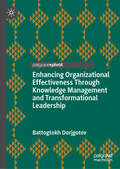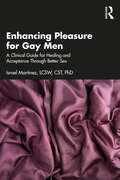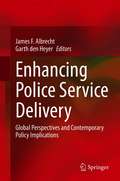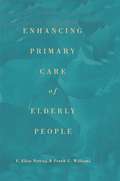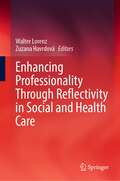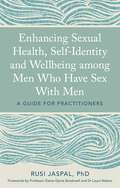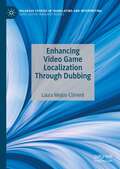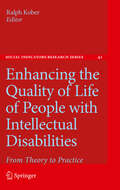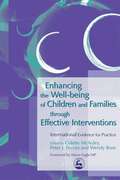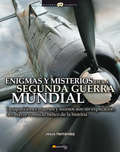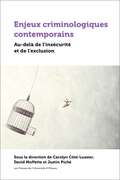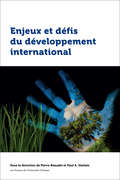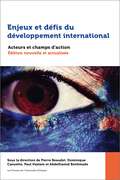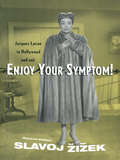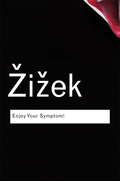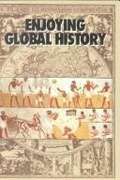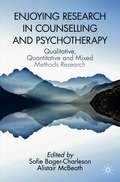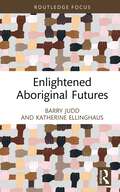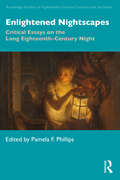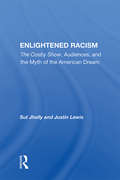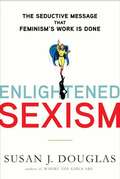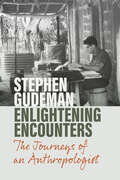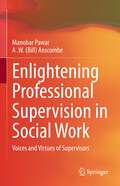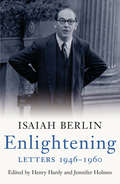- Table View
- List View
Enhancing Organizational Effectiveness Through Knowledge Management and Transformational Leadership
by Battogtokh DorjgotovThis book introduces the study of the impacts on organizational culture, strategy, technology, human resource development (HRD), transformational leadership, knowledge management, and organizational effectiveness using a hypothesis-driven model. The model posits that organizational culture, technology, strategy, and HRD are essential preconditions for effective knowledge management, which is further enhanced by transformational leadership. Focusing on Research and Development (R&D) organizations, specifically the research institutes of the Mongolian Academy of Sciences, the study examines how these factors collectively improve organizational effectiveness. Concluding with practical recommendations for R&D specialists and managers, the book offers insights into enhancing organizational efficiency through strategic leadership and robust knowledge management practices.
Enhancing Pleasure for Gay Men: A Clinical Guide for Healing and Acceptance Through Better Sex
by Israel MartinezThis book aims to help therapists understand the challenges gay men face in their sex lives, providing professionals and gay men with evidence-based interventions and clinical tools to help them heal and live overall healthier lives.Gay men have unique and debilitating issues that can get in the way of them having pleasurable sex. Instead of sex being a space to learn about themselves, heal, release, and receive joy, for many sex is fraught with shame, anxiety, self-hate, and feeling isolated. Written for both professionals and the clients they treat, this book aims to heal sex-related wounds through sex and, in turn, improve every aspect of gay men’s mental health. The book begins by exploring what is special about gay men and sex before looking at assessing and presenting medical issues impacting sexual functioning, such as childhood trauma, attachment styles, body issues, anxiety, depression, long-term relationships and parenting, and hookup apps. It then moves onto clinical interventions to address these issues, with intake questionnaires and information on how to adapt sensate focus exercises, neuroscience, narrative, CBT, and somatic modalities to provide sex therapy interventions specific to gay men.With special focus on marginalized communities within the LGBTQIA+ community, such as trans men, BIPOC, aging, disabled, and chronically ill voices, this book is essential reading for sex therapists and mental health professionals working with gay men, as well as gay men themselves looking to live authentically and happily in their sexual lives.
Enhancing Police Service Delivery: Global Perspectives and Contemporary Policy Implications
by James F. Albrecht Garth Den HeyerContemporary police service delivery and performance are complex phenomena. Law enforcement, particularly at the local level, must therefore face the additional challenges of globalization, cybercrime, counter-terrorism and calls for reform, at a time when extreme budgetary constraints are being implemented. Policing operations encompass multiple critical tasks and responsibilities not routinely measured and evaluated, such as response to incidents involving medical assistance, homelessness, mental illness, community engagement, and neighborhood problem-solving endeavors. This volume aims to provide government, criminal justice and policing administrators, policy makers and criminal justice scholars and researchers with comprehensive analyses of the critical issues impacting the challenges inherent in providing effectual public safety, security and service, all from a global perspective. It takes into account popular criticism, extreme budgetary constraints, and the relatively novel and overwhelming challenges of terrorism and cybercrime. The book merges study and practice to identify avenues to best serve community interests, ensure organizational success, and enhance public confidence in policing and in rule of law.
Enhancing Primary Care of Elderly People (Garland Reference Library Of Social Science Ser. #Vol. 1142)
by F. Ellen Netting Frank G. WilliamsFirst published in 1999. Routledge is an imprint of Taylor & Francis, an informa company.
Enhancing Professionality Through Reflectivity in Social and Health Care
by Walter Lorenz Zuzana HavrdováThis book discusses complex motivational conditions and strategies on macro, meso, and micro levels promoting reflectivity in interpersonal professional practice. The increasing demands made on practitioners in social and health services, as illustrated by the COVID-19 pandemic, can lead to great uncertainty over how to find "the right response" to complex expressions of need and how to account for ethical professional decisions in view of prevailing strategies of 'risk reduction' and managerial accounting. Reflectivity has been recognised as being of central importance for guiding practitioners towards situationally differentiated and accountable practice. However, it is a complex process made up not only of different psychological components and their interplay with educational and organisational contexts, but also of multilevel interactions and purely situational conditions that can have positive or negative effects. The individual and team reflectivity can be learned and supported through various educational and managerial opportunities, sensitively guided personal and professional experiences and specific patterns of interaction which are reviewed in the book. Reflective supervision in the workplace plays a pivotal role in enabling individual and team reflective processes. However, there are also social and organisational factors that can hinder the development of individual and team reflectivity. The particular value of this publication is that the authors focus on complex research findings from several consecutive studies and critically review and discuss the conditions for reflectivity from various perspectives and with the background of rich academic literature and research. Their research-derived empirical and analytical insights were submitted to managers and educators, and effective and realistic strategies and methods to enhance different levels of reflectivity in students and practitioners were discussed and are summarised in this volume. Among the topics covered: The significance of reflectivity in professional social and health care in relation to changing socio-political contexts Gender aspects of reflectivity in the social and healthcare field Operationalisation of reflectivity for research by personal, team and organisational scales Cultural and communicational patterns of interaction enabling professional reflective processes Enhancing Professionality Through Reflectivity in Social and Health Care is pertinent reading for professors of professional academic training programmes for social workers, nurses, supervisors, trainers in non-formal learning settings, students, and managers of social and health services with an interest in enhancing organisational cultures.
Enhancing Sexual Health, Self-Identity and Wellbeing among Men Who Have Sex With Men: A Guide for Practitioners
by Rusi Jaspal Dr Laura Waters Professor Dame BreakwellBy analysing research into links between low psychological wellbeing and sexual risk-taking behaviours that occur in men who have sex with men (MSM), this book demonstrates what impact social and psychological interventions could have on MSM at risk of poor sexual outcomes. At the heart of the book is Identity Process Theory, co-developed by the author, a social psychological theory of identity construction, threat and coping. The book considers the emerging debates in MSM's health, such as the use of Grindr and 'chemsex', and also explores the socio-structural factors, such as homophobia and stigma, that threaten the self-identity of MSM. The book offers principles and techniques from this theory that can be used as an effective intervention and therapeutic model with MSM to build more positive identities and reduce sexual risk-taking.
Enhancing Video Game Localization Through Dubbing (Palgrave Studies in Translating and Interpreting)
by Laura Mejías-ClimentThis book addresses the hot topic in audiovisual translation (AVT) of video game localization through the unique perspective of dubbing, an area which has so far received relatively little scholarly focus. The author analyses the main characteristics of video game localization within the context of English-Spanish dubbing, and emphasizes the implications for research and localization as a professional practice. The book will appeal to translation studies scholars and students, as well as AVT professionals looking to understand localization processes from a systematized approach.
Enhancing the Quality of Life of People with Intellectual Disabilities
by Ralph KoberThis book contains a series of articles, written by international experts in the fields of intellectual disability and quality of life, that explore a broad range of issues that impact on the quality of life of people with intellectual disabilities and their families. The book commences with a general discussion on defining quality of life and family quality of life and the appropriateness of using these constructs in the field of intellectual disability, and is followed by an analysis on the effects of living arrangements and employment on quality of life. The book concludes with discussions on the unique issues facing children with intellectual disabilities and people living in developing countries and the effect these issues have upon their quality of life.
Enhancing the Well-being of Children and Families through Effective Interventions: International Evidence for Practice
by Ian Sinclair Kate Wilson Jim Wade Wendy Rose Danielle Turney Arnon Bentovim David Quinton Peter Pecora Karen Tanner Colette McauleyServices for families and children are rightfully the focus of intense scrutiny and debate, and there is a clear need to establish a knowledge of which services work well. This volume provides a comprehensive overview of research evidence from the UK and USA on the effectiveness of selected child welfare interventions. It addresses the challenges of measuring effectiveness in child welfare and explains the policy context for child welfare service delivery. Leading international contributors summarize the evidence of effectiveness in each core area, and consider the impact on children's development, parenting capacity and the wider community. Critically, the book also draws out the implications of the evidence for policy, practice and service delivery as well as for future research. This book is essential reading for policy makers, practitioners and commissioners of services in child welfare as well as students and researchers.
Enid Blyton: The Biography
by Barbara StoneyEnid Blyton is known throughout the world for her imaginative children's books and her enduring characters such as Noddy and the Famous Five. She is one of the most borrowed authors from British libraries and still holds a fascination for readers old and young alike. Yet until 1974, when Barbara Stoney first published her official biography, little was known about this most private author, even by members of her own family.The woman who emerged from Barbara Stoney's remarkable research was hardworking, complex, often difficult and, in many ways, childlike. Now this widely praised classic biography has been fully updated for the twenty-first century and, with the addition of new colour illustrations and a comprehensive list of Enid Blyton's writings, documents the growing appeal of this extraordinary woman throughout the world. The fascinating story of one of the world's most famous authors will intrigue and delight all those with an interest in her timeless books.
Enigmas y misterios de la Segunda Guerra Mundial (Historia Incógnita)
by Jesús Hernández MartínezEnigmas y misterios de la Segunda Guerra Mundial es una apasionante recopilación de sucesos inexplicados, misteriosas desapariciones, enigmáticos espías, y otros hechos desconocidos de la mayor contienda de la historia de la humanidad tratados con rigor histórico y amenidad. El libro imprescindible para conocer la II Guerra Mundial menos conocida.
Enjeux criminologiques contemporains: Au-delà de l’insécurité et de l’exclusion
by Carolyn Côté-Lussier, David Moffette et Justin PichéEnjeux criminologiques contemporains : Au-delà de l’insécurité et de l’exclusion confronte certaines des questions pressantes relatives aux pratiques pénales et carcérales, à la criminologie « clinique », et au contrôle du crime et ses conséquences. Cet ouvrage présente des théories et des méthodes à la pointe de la recherche, dans le but explicite de contribuer au développement de politiques qui promeuvent la sécurité et l’inclusion sociale. Les approches et théories critiques explorées dans cet ouvrage servent de contrepoint aux approches d’ordre administratif ou managérial et aux politiques et pratiques étatiques punitives, fondées sur l’exclusion. Décliné en deux volumes – l’un en français et l’autre en anglais –, ce live rassemble autant des experts éminents que des chercheurs émergents qui, ensemble, o rent une importante contribution a? l’avancement de la recherche et des politiques publiques. Publié en français. Également disponible en anglais : Contemporary Criminological Issues: Moving Beyond Insecurity and Exclusion.
Enjeux et défis du développement international (Études en développement international et mondialisation)
by Dominique Caouette Abdelhamid BenhmadeDans un monde en crise multiple, le domaine du développement international a bien changé. Des pays dits « émergents » contestent l’espace qui était réservé auparavant aux pays dits « riches ». Des mouvements populaires d’une ampleur sans précédent occupent la rue. Des mégaentreprises deviennent aussi importantes que les États. Dans tout cela, de « vieux » démons persistent : la pauvreté extrême, l’exclusion, le non-respect des droits. Il faut de nouvelles solutions, de nouvelles manières de s’en sortir ; c’est ainsi que le monde du développement apparaît comme un gigantesque laboratoire.Dans cet ouvrage sont abordées les grandes thématiques de ce développement en changement. Le monde peut-il être changé ? Comment ? Qui sont les acteurs, ceux et celles qui peuvent agir ? Que dire des grandes institutions, l’ONU par exemple ? La place des femmes est devenue centrale dans tout processus de changement, en même temps persiste la discrimination. La dette, la famine, l’analphabétisme, les épidémies sont des problèmes complexes : peuvent-ils être surmontés ? Comment faire face aux grandes crises humanitaires qui résultent des guerres et des catastrophes qu’on dit « naturelles » ?Dans cet ouvrage écrit à plusieurs mains, on trouvera ce grand brassage d’idées qui parcourt le monde du développement et qui exprime mille voix, mille alternatives, partageant toutes cependant une volonté éthique et intellectuelle, à la recherche d’un monde plus juste, plus équitable, plus démocratique.
Enjeux et défis du développement international: Acteurs et champs d'action. Édition nouvelle et actualisée (Études en développement international et mondialisation)
by sous la direction de Pierre Beaudet, Dominique Caouette, Paul A. Haslam et Abdelhamid BenhmadeLe développement international est un territoire contesté. À cause de l’aggravation des écarts entre le Nord et le Sud, de l’accroissement de la pauvreté mondiale et de l’urgence écologique, de nouveaux défis sociétaux émergent, s’accumulent et conduisent à des besoins criants qu’une aide internationale parvient de moins en moins à combler.Malgré ces tensions, des communautés du Nord et du Sud tentent de reprendre les choses en main et de réinventer le développement autour de principes clés : le respect de la diversité humaine ; le droit de vivre dignement ; le lien organique qui lie les êtres humains ; la vie non humaine ; la nature ; et l’importance de la participation ainsi qu’une démocratie qui dépasse les limites étroites dans lesquelles elle est présentement confinée.Cette édition nouvelle et actualisée regroupe des chercheurs de contextes divers, à travers le monde, qui s’unissent pour comprendre non seulement le « pourquoi » de cette situation critique, mais aussi le « comment », qui permettrait de remettre le monde, et le développement, à l’endroit.Publié en français
Enjoy Your Symptom!: Jacques Lacan in Hollywood and Out
by Slavoj ŽižekSlavoj Zizek, dubbed by the Village Voice "the giant of Ljubljana," is back with a new edition of his seriously entertaining book on film, psychoanalysis (and life). His inimitable blend of philosophical and social theory, Lacanian analysis, and outrageous humor are made to show how Hollywood movies can explain psychoanalysis-and vice versa using films such as Marnie and The Man Who Knew Too Much.
Enjoy Your Symptom!: Jacques Lacan in Hollywood and Out (Routledge Classics Ser.)
by Slavoj ZizekThe title is just the first of many startling asides, observations and insights that fill this guide to Hollywood on the Lacanian psychoanalyst’s couch. Zizek introduces the ideas of Jacques Lacan through the medium of American film, taking his examples from over 100 years of cinema, from Charlie Chaplin to The Matrix and referencing along the way such figures as Lenin and Hegel, Michel Foucault and Jesus Christ. Enjoy Your Symptom! is a thrilling guide to cinema and psychoanalysis from a thinker who is perhaps the last standing giant of cultural theory in the twenty-first century.
Enjoying Global History
by Henry Abraham Irwin PfefferTo give reluctant readers a basic text that brings history to life, and to provide all readers with a high-interest supplementary resource text.
Enjoying Research in Counselling and Psychotherapy: Qualitative, Quantitative and Mixed Methods Research
by Sofie Bager-Charleson Alistair McBeathThis textbook provides a guide to the development of a rigorous and creative research-supported practice for students, practitioners, and researchers in counselling and psychotherapy. With an emphasis on critical thinking and “research mindedness”, it introduces practical research skills and links them to self-awareness and critical reflection. Learning how to creatively and effectively use oneself in the treatment process is an essential component in therapy training and this level of self-awareness has long been a neglected area in research – until now. With examples ranging from private therapeutic practice to psychiatric related research, each chapter combines ‘how-to-do-it’ advice with illustrative real-life examples. The authors outline the use of a broad range of research methods, embracing Arts- as well as RCT-based research, and covering qualitative, quantitative, pluralistic and mixed methods approaches. Whether you are engaging with research for the first time or already developing your own research projects, if you are a student at diploma level or taking a Postgraduate research course for counsellors, psychotherapists and counselling psychotherapists, this is essential reading for anyone looking for a book that combines self-awareness with analytical and practical skills.
Enlightened Aboriginal Futures (Short Takes on Long Views)
by Katherine Ellinghaus Barry JuddThis book examines the radical intervention of the German-Australian Lutheran missionary F. W. Albrecht in the education of Aboriginal children. Albrecht’s ideas about consent, freedom of choice and personal autonomy were expressed in schemes designed to educate and empower Aboriginal people and efforts to find Aboriginal futures through education, training and employment. This book explores how Aboriginal people understood Albrecht’s work and the Enlightenment concepts on which it was based. In the context of an Anglo-Australian settler-colonialism that sought to systematically remove the freedom and autonomy of Indigenous people, this study demonstrates how those who participated in the Albrecht scheme were able to reconstruct themselves in ways that fused their own Aboriginal culture and identity with the ideas and values imported from an enlightened Germany. This book will appeal to students and scholars of cultural history, colonialism, Lutheranism, race and ethnicity and Indigenous studies. It will also be illuminating reading to policymakers searching for a deeper understanding of colonial interventions in Indigenous communities.
Enlightened Nightscapes: Critical Essays on the Long Eighteenth-Century Night (Routledge Studies in Eighteenth-Century Cultures and Societies)
by Pamela F. PhillipsThis volume brings together eleven case studies that address how the night became visible in the long and global eighteenth century through different mediums and in different geographical contexts. Situated on the eve of the introduction of artificial lighting, the long eighteenth century has much to say about night’s darkness and brilliance. The eighteenth century has been bound up epistemologically with images of light, reason, and order. Night and day, light and darkness, reason and mystery, however, are not necessarily at odds in the eighteenth century. In their analysis of narratives, poetry, urban spaces, music, the visual arts, and geological phenomena, the essays provide various frameworks to examine the representation, treatment, and meaning of the enlightened night. The transnational and multidisciplinary nature of the volume presents a survey of the research currently being done in the field of the long eighteenth-century night. This collection contributes to an ongoing exercise that questions the accepted definitions of the Enlightenment, and by bringing Eighteenth-Century Studies into dialogue with Night Studies, it enriches the critical conversation between these lines of research.
Enlightened Racism: The Cosby Show, Audiences, And The Myth Of The American Dream
by Sut JhallyThe Cosby Show needs little introduction to most people familiar with American popular culture. It is a show with immense and universal appeal. Even so, most debates about the significance of the program have failed to take into account one of the more important elements of its success—its viewers. Through a major study of the audiences of The Cosby Show, the authors treat two issues of great social and political importance—how television, America's most widespread cultural form, influences the way we think, and how our society in the post-Civil Rights era thinks about race, our most widespread cultural problem. This book offers a radical challenge to the conventional wisdom concerning facial stereotyping in the United States and demonstrates how apparently progressive programs like The Cosby Show, despite good intentions, actually help to construct "enlightened" forms of racism. The authors argue that, in the post-Civil Rights era, a new structure of racial beliefs, based on subtle contradictions between attitudes toward race and class, has brought in its wake this new form of racial thought that seems on the surface to exhibit a new tolerance. However, professors Jhally and Lewis find that because Americans cannot think clearly about class, they cannot, after all, think clearly about race. This groundbreaking book is rooted in an empirical analysis of the reactions to The Cosby Show of a range of ordinary Americans, both black and white. Professors Jhally and Lewis discussed with the different audiences their attitudes toward the program and more generally their understanding and perceptions of issues of race and social class. Enlightened Racism is a major intervention into the public debate about race and perceptions of race—a debate, in the 1990s, at the heart of American political and public life. This book is indispensable to understanding that debate.
Enlightened Sexism: The Seductive Message that Feminism's Work is Done
by Susan J. DouglasFrom the author of "Where the Girls Are" comesa sharp and irreverent critique of how women are portrayed in today's popular culture. Women today are inundated with conflicting messages from the mass media: they must either be strong leaders in complete command or sex kittens obsessed with finding and pleasing a man. In "Enlightened Sexism," Susan J. Douglas, one of America's most entertaining and insightful cultural critics, takes readers on a spirited journey through the television programs, popular songs, movies, and news coverage of recent years, telling a story that is nothing less than the cultural biography of a new generation of American women. Revisiting cultural touchstones from Buffy the Vampire Slayer to Survivor to Desperate Housewives, Douglas uses wit and wisdom to expose these images of women as mere fantasies of female power, assuring women and girls that the battle for equality has been won, so there's nothing wrong with resurrecting sexist stereotypes--all in good fun, of course. She shows that these portrayals not only distract us from the real-world challenges facing women today but also drive a wedge between baby-boom women and their "millennial" daughters. In seeking to bridge this generation gap, Douglas makes the case for casting aside these retrograde messages, showing us how to decode the mixed messages that restrict the ambitions of women of all ages.
Enlightening Encounters: The Journeys of an Anthropologist
by Stephen GudemanOne of the world's top anthropologists recounts his formative experiences doing fieldwork in this accessible memoir ideal for anyone interested in anthropology. Drawing on his research in five Latin American countries, Steve Gudeman describes his anthropological fieldwork, bringing to life the excitement of gaining an understanding of the practices and ideas of others as well as the frustrations. He weaves into the text some of his findings as well as reflections on his own background that led to better fieldwork but also led him astray. This readable account, shorn of technical words, complicated concepts, and abstract ideas shows the reader what it is to be an anthropologist enquiring and responding to the unexpected. From the Preface: Growing up I learned about making do when my family was putting together a dinner from leftovers or I was constructing something with my father. In fieldwork I saw people making do as they worked in the fields, repaired a tool, assembled a meal or made something for sale. Much later, I realized that making do captures some of my fieldwork practices and their presentation in this book.
Enlightening Professional Supervision in Social Work: Voices and Virtues of Supervisors
by Manohar Pawar A .W. AnscombeThis book is a response to the felt need of social work practitioners for professional supervision. Reflecting on the social work profession in the context of contemporary socio-economic and political challenges and wide-ranging organizational and practice settings, the book provides a voice for supervisors to share their experiences. Social workers often deal with difficult, undefined and unique human situations where there are no ready-made solutions or quick fixes. This constant and complex working process can cause stress, burnout and affect their quality of work and judgement if they are not supported appropriately and in a timely way. One such support to them is offering professional supervision to enhance their professional functioning and their quality of service. On the one hand, the narratives of experienced supervisors reveal critical dilemmas, core processes and content, expectations, issues posed, and concepts and theories employed in professional supervision, and on the other, the wisdom and qualities of supervisors. This book analyzes concepts and models employed by supervisors and the complex interaction of their qualities and wisdom that arise from their narratives. It underscores the supervisee's being through integrating the personal and professional self to deliver better quality services to people, agencies, and communities. The book argues that the current trends compel action for well thought through professional supervision for all who need it. Those interested in professional supervision – supervisees, practitioners, and supervisors – will benefit from reading this book. Enlightening Professional Supervision in Social Work: Voices and Virtues of Supervisors is the resource that both supervisors and practitioners need to create safe environments to carefully reflect, develop knowledge, sharpen skills and effectively engage in practice. It will improve services to clients and organizational service provision, and not only benefit both practitioners and supervisors in social work and human services, but also social work educators and students, social policy administrators as well as managers and trainers in the social services sector.
Enlightening: Letters 1946 - 1960
by Isaiah Berlin'People are my landscape', Isaiah Berlin liked to say, and nowhere is the truth of this observation more evident than in his letters. He is a fascinated watcher of human beings in all their variety, and revels in describing them to his many correspondents. His letters combine ironic social comedy and a passionate concern for individual freedom. His interpretation of political events, historical and contemporary, and his views on how life should be lived, are always grounded in the personal, and his fiercest condemnation is reserved for purveyors of grand abstract theories that ignore what people are really like.This second volume of Berlin's letters takes up the story when, after war service in the United States, he returns to life as an Oxford don. Against the background of post-war austerity, the letters chart years of academic frustration and self-doubt, the intellectual explosion when he moves from philosophy to the history of ideas, his growing national fame as broadcaster and lecturer, the publication of some of his best-known works, his election to a professorship, and his reaction to knighthood.These are the years, too, of momentous developments in his private life: the bachelor don's loss of sexual innocence, the emotional turmoil of his father's death, his courtship of a married woman and transformation into husband and stepfather. Above all, these revealing letters vividly display Berlin's effervescent personality - often infuriating, but always irresistible.
